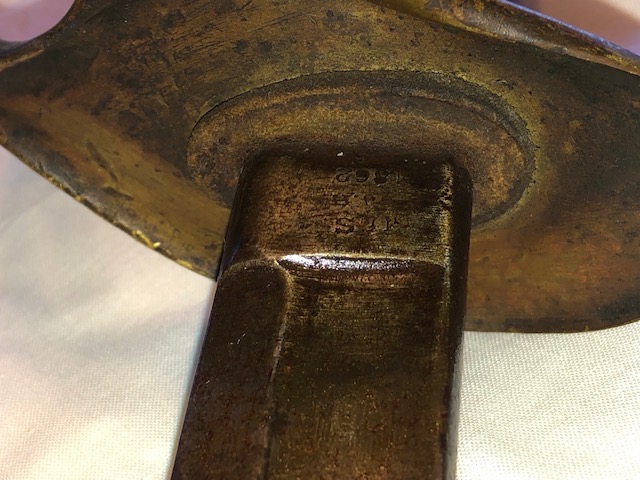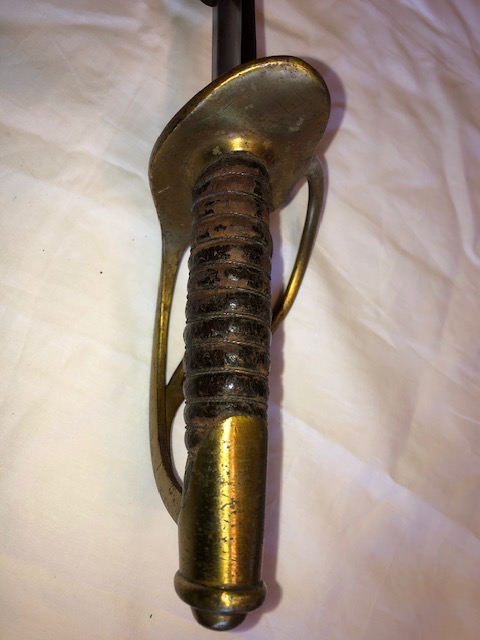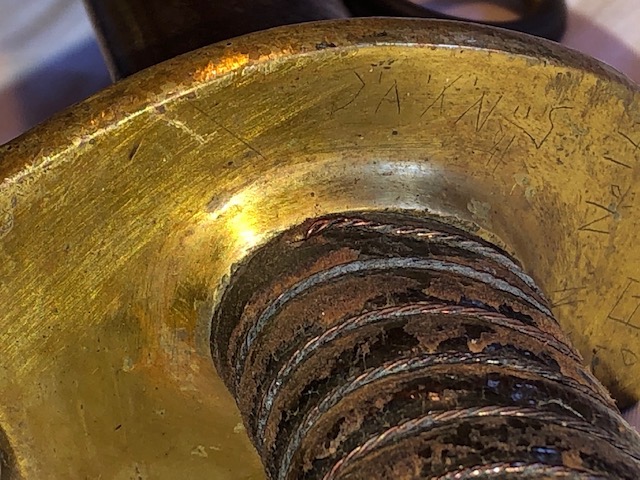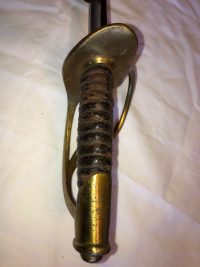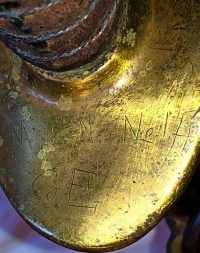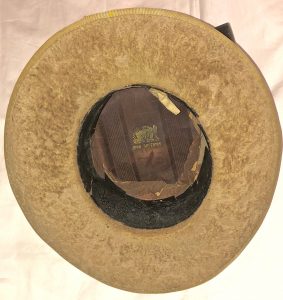Id’d Mansfield and Lamb M1860 Light Cavalry Saber – 5th NY Cavalry
This M1860 Light Cavalry saber is in overall excellent condition; it was manufactured by one of the more desirable contractors – Mansfield & Lamb of Forestdale, Rhode Island. The grip’s leather wrap is complete, exhibiting some finish loss; the twisted brass wire is in good condition, as are the guard, knucklebow and pommel; the scabbard is in good shape, as well; the blade exhibits a gray patina and wear, but is in good shape. The original leather washer is present where the blade enters the hilt.
SOLD
This M1860 Light Cavalry saber is in overall excellent condition; it was manufactured by one of the more desirable contractors – Mansfield & Lamb of Forestdale, Rhode Island. The grip’s leather wrap is complete, exhibiting some finish loss; the twisted brass wire is in good condition, as are the guard, knucklebow and pommel; the scabbard is in good shape, as well; the blade exhibits a gray patina and wear, but is in good shape. The original leather washer is present where the blade enters the hilt. The ricasso is marked – “MANSFIELD & LAMB / FORESTDALE RI” on one side and is stamped – “U.S. / JR / 1862” on the opposite side. Interestingly, scratched into the wide area of the brass hilt guard is the following –
“M. L. N. No 1 H
Co. E
5th NY VC”
The initials are those of Malcolm L. Nash, Co. E, 5th New York Volunteer Cavalry. Nash enlisted as a Corporal, in August of 1861. He would be promoted to the rank of Quarter Master Sergeant and was apparently discharged for disability, in November of 1862. Nash’s service did include his unit’s participation in the defenses of Washington and action in the Valley of Virginia at Strasburg, Middletown and Front Royal, where the 5th NY Cavalry sustained 75 men killed, wounded and missing in action. This is a fine example of a less commonly encountered M1860 contract saber, identified to a Union cavalry NCO.
Malcom L. Nash
Residence was not listed; 30 years old. Enlisted on 8/17/1861 at Cuba, NY as a Corporal. On 8/31/1861 he mustered into “E” Co. NY 5th Cavalry He was discharged for disability on 11/15/1862 (Estimated day of disch) Promotions: * Qtr Master Serg
5th NY Cavalry
( 3-years )
Organized: Camp Scott, Staten Island, NY on 11/14/61
Mustered Out: 7/19/65 at Winchester, VA
Officers Killed or Mortally Wounded: 8
Officers Died of Disease, Accidents, etc.: 3
Enlisted Men Killed or Mortally Wounded: 93
Enlisted Men Died of Disease, Accidents, etc.: 222
(Source: Fox, Regimental Losses)
| From | To | Brigade | Division | Corps | Army | Comment |
| Nov ’61 | Mar ’62 | Dix’s | Army of Potomac | Baltimore, MD, New Organization | ||
| Mar ’62 | Apr ’62 | Cavalry | 5 | Army of Potomac | ||
| Apr ’62 | Jun ’62 | Cav Command | Department of the Shenandoah | |||
| Jun ’62 | Sep ’62 | Cavalry | 2 | Army of Virginia | ||
| Sep ’62 | Mar ’63 | Cavalry | Dist of Alexandria | Military District of Washington | ||
| Feb ’63 | Mar ’63 | Cavalry | 22 | Department of Washington, D.C. | ||
| Mar ’63 | Jun ’63 | 3 | Cavalry | 22 | Department of Washington, D.C. | |
| Jun ’63 | Aug ’64 | 1 | 3 | Cavalry | Army of Potomac | |
| Aug ’64 | Mar ’65 | 1 | 3 | Cavalry | Army of the Shenandoah | |
| Mar ’65 | Jul ’65 | Cavalry | Army of the Shenandoah | Mustered Out |
NEW YORK
FIFTH CAVALRY
(Three Years)
Fifth Cavalry.-Cols., Othneil De Forest, John Hammond, Amos H. White; Lieut.-Cols., Robert Johnstone, John Hammond, William P. Bacon, Amos H. White, Theodore A. Boice; Majs., Philip G. Vaught, Washington Wheeler, John Hammond, Abram H. Krom, Elmer J. Barker, James Davidson, William P. Pratt, Amos H. White, Theodore A. Boice, George H. Gardner, William P. Bacon, James A. Penfield, Tiberly C. Abbott, Henry A. D. Merritt. Authority to recruit this regiment was received by Col. De Forest from the war department on July 26, 1861. The regiment, originally known as the “Ire Harris cavalry,” rendezvoused at Camp Scott, Staten island, where it was mustered into the U. S. service from Aug. 15 to Oct 31, 1861. The companies of which it was composed were principally recruited in the counties of New York, Kings, Allegany, Cattaraugus, Wyoming, Tioga, Essex and Greene. A part of Co. D came from Springfield, Mass., and part of Co. I from Princeton, Passaic and Plainfield, N. J. The original members were mustered out by detachments in 1864 and the regiment, composed of veterans and recruits, continued in service until July 19, 1865, when it was mustered out and honorably discharged at Winchester, Va. The regiment left the state, nearly 1,200 strong, Nov. 18, 1861, and was stationed at Annapolis until the spring of 1862. That year it served in the 5th corps, Department of the Shenandoah; in the 2nd corps, Army of Virginia; and in Stahel’s division in the defenses of Washington. It started on its first campaign down the Shenandoah Valley in April, 1862, and at Front Royal, Strasburg and Middletown, sustained a loss of 75 killed, wounded and missing. As Gen. Banks fell back before Gen. Jackson, the regiment was cut off at Strasburg, but saved Banks’ wagon train and Hampton’s battery, and escorted them in safety by a circuitous route through the mountains into Maryland. It lost 24 men at Barnett’s ford, and 23 in an action near Orange Court House. In the latter engagement it distinguished itself by driving the 7th Va. cavalry and capturing 47 prisoners, including the commanding officer, Maj. Marshall. It took an active part in Gen. Pope’s campaign, being selected as body-guard to that general. In 1863 the regiment served in the 3d brigade, 3d division, 22nd corps at Washington; in the 1st and 2nd brigades, 3d cavalry division, Army of the Potomac; and was repeatedly in action during the year, its heaviest losses being sustained at Little River turnpike, loss 42; at Hanover, Pa., loss 54; at Hagerstown, loss 91; at Brandy Station, loss 25; and in a second action there, loss 28; at Buckland mills, loss 22. It then served with the cavalry corps, Army of the Potomac, until Oct., 1864; in the Army of the Shenandoah until the opening of the final campaign in 1865; and in the Department of West Virginia from March, 1865. It participated in Kilpatrick’s raid to Richmond in the spring of 1864, sustaining considerable loss, Maj. Merritt, being among the captured. It was heavily engaged at the battle of the Wilderness, where it opened the fight at Parker’s store, and met with a loss of 63 killed, wounded and missing. Its losses at Spottsylvania Court House were 16; at North Anna 25; at Cold Harbor 43; in the raid to the South Side and Danville railroads in June 98; at Smithfield 19; and at the Opequan 17. The regiment returned home under command of Col. White, with only about 550 men out of a total enrollment of nearly 2,500. It had participated in nearly 175 battles and skirmishes and established a well-earned reputation for gallantry and high soldierly conduct. Its total losses by death were 5 officers and 62 men killed in action; 2 officers and 24 men died of wounds received in action, 4 officers and 222 men died of disease, accident and other causes, a total of 11 officers and 308 men, of whom 99 died in Confederate prisons, a larger loss from this source than was sustained by other cavalry regiment from the state. Medals of honor were conferred upon three of the regiment by the secretary of war for distinguished gallantry in action, viz.: Sergt. Thomas Burke, for capture of a battleflag at Hanover, Pa.; Sergt. David S. Scofield, for the capture of a flag at Cedar creek, Va.; and on Corp. John Walsh, for the capture of a flag at the same engagement. Source: The Union Army, Vol. 2, p. 185 ************************************************************************************* New York FIFTH REGIMENT OF CAVALRY (VETERAN). Ira Harris Cavalry; First Ira Harris Guard; De Forrest Cavalry. (Three Years) July 26, 1861, Col. Othneil De Forrest received authority from the War Department to recruit a brigade of cavalry for a service of three years. He recruited this regiment, as the Ira Harris Cavalry; after the organization had been turned over to the State, it was, October 16, 1861, designated the First Ira Harris Guard, and after its completion, November 14, 1861, the 5th Regiment of Cavalry. The Bliss Cavalry, an incomplete organization, recruited by Col. W. S. Bliss, was merged into the regiment, which was organized at Camp Scott, Staten Island, where its companies were mustered in the service of the United States: A on August 15, 1861; B on August 21, C on September 3, D on October 1, E on the 7th, and F on the 21st of September, G on the 9th, H on the 28th, and I, K, L and M, on the 31st of October, 1861. At the expiration of its term of service those entitled thereto were discharged and the regiment continued in the service. The companies were recruited principally: A, B, K–Bliss Cavalry, M–Bliss Cavalry–at New York city; C at New York city, Troy and Kingston; D at Springfield, Mass., and New York city; E at Allegany, Kennedy, Richburgh, Belmont, East Rushford, Friendship, Ellicottsville, Cuba, Black Creek, Little Valley, Scio, Genesee, Farmersville, Great Valley and Wellsville; F at East Pike, East Gainesville, Castile, Attica, Oramel, Wellsville, China, Hume, Sardinia and Freedom; G, intended originally for a so-called Harlan’s Cavalry, at Pike, Oswego and Elmira; H at Crown Point; I–Bliss Cavalry–at Princeton, Passaic and Plainfield, N. J., and Brooklyn and Newburgh; and L at Hudson, Athens and Catskill. The regiment left the State November 18, 1861, and served in the Department of Annapolis, Md., from November, 1861; in the 5th Corps and Department of the Shenandoah, from March, 1862; in the 2d Corps, Army of Virginia, from June, 1862; in Stahel’s Division, defenses of Washington, from September, 1862; in the 3d Brigade, 3d Division, 22d Corps, Department Washington, from March, 1863; in the 1st Brigade, 3d Division, Cavalry, Army of the Potomac, from June 28, 1863; in the 2d Brigade, 3d Division, Cavalry, Army of the Potomac, from August, 1863; in the 1st Brigade, 3d Division, Cavalry, Army of the Potomac, from September, 1863; with the Army of the Potomac, detached in the 9th Corps, part of May, 1864; with the Cavalry Corps again from about end of May, 1864; in the Army of the Shenandoah, from October, 1864, and in the Department of West Virginia, from March, 1865, until July 19, 1865, when, commanded by Col. Amos H. White, it was mustered out and honorably discharged at Winchester, Va. Source: Phisterer, p. 822
Historical Sketch
Of The 5th Cavalry Regiment, New York
History
Taken from Final Report on the Battlefield of Gettysburg (New York at Gettysburg) by the New York Monuments Commission for the Battlefields of Gettysburg and Chattanooga. Albany, NY: J.B. Lyon Company, 1902.
By C. T. S. Pierce
On the 26th of July, 1861, the Secretary of War authorized Col. Othniel DeForest, of New York City, to raise a regiment of cavalry. By the last of the following September there had been gathered on Staten Island, New York Harbor, the nucleus of a fine cavalry brigade. From this assemblage of recruits was organized the Fifth New York Cavalry, known as the ” First Ira Harris Guard,” in honor of Senator Ira Harris of Albany. New York City had contributed liberally of men, though whole companies and parts of companies were raised in Essex, Wyoming, Allegany and Tioga Counties. A Jew men were also obtained from the States of Massachusetts, Connecticut, and New Jersey. No bounties were paid to recruits; but a bounty of $100 was promised to be paid by the United States, at the expiration of term of service.
On the 1st of October, 1861, on Staten Island, New York Harbor, the field and staff of the regiment were mustered into the service of the United States for three years by Capt. L. S. Larned of the United States Army. The muster took effect from this date. October 31st, the regiment was inspected for the first time by Lieut. Col. D. B. Sackett, of the United States Army. The last company had now been mustered in, and the command stood with a strength of 1,064 men
In November, 1861, the regiment was ordered to Annapolis, Md. On the 28th, the men pitched their tents about three miles from the city, at ” Camp Harris,” where they were drilled and instructed by that thorough disciplinarian, Gen. John P. Hatch, also of the United States Army. The last of March, 1861, the regiment broke camp, having been ordered to the Shenandoah Valley to report to Gen. Hatch, commanding cavalry under General Banks. It reported to him at Harrisonburg, on May 3d. The regiment served in Banks’ campaign in the Shenandoah Valley, its first skirmish being at Port Republic, on May 2, 1862. From this time on until the close of the war it saw continuous active service. During July, it did picket and scouting duty along the Blue Ridge and in Central Virginia. On August 2d, under General Crawford, it was engaged in a cavalry battle at Orange Court House, Va. In Pope’s campaign it participated in the battles of Cedar Mountain, Groveton, Second Bull Run. and Chantilly.
The fall and winter of 1862 and 1863 were spent in Virginia doing outpost under command of Major General Stahel, In June, 1863, General Pleasanton reviewed Stahel’s Division, after which the entire force was reorganized, it becoming that famous Third Division, Cavalry Corps, Army of the Potomac, with General Kilpatrick in command. The First Brigade consisted of the First Vermont, First W. Virginia, Eighteenth Pennsylvania, and Fifth New York, Brigadier General Farnsworth commanding. General Custer commanded the Second Brigade, which was composed of Michigan regiments.
The division then started on the Gettysburg campaign, during which the regiment was constantly engaged. General Farnsworth was killed at Gettysburg, and the regiment lost heavily in officers and men at Hanover, Pa., Gettysburg, Monterey Pass, Hagerstown, and Boonsborough.
The Fifth Cavalry, commanded by Col. John Hammond, of Crown Point, N. Y., had already signalized itself under its intrepid leader, General (then Major) Hammond, in the sanguinary struggles of the Army of the Potomac, with its desperate foe, the army of General Lee. On the 30th of June, 1863, at Hanover, Pa., fourteen miles from Gettysburg, this regiment was the first to exchange shots and cross sabres on free soil with the daring and desperate invaders who fought under the justly celebrated leader of the Confederacy, Gen. J. E. B. Stuart. That accurate military critic, the Comte de Paris, himself a participant in most of our great battles of the War of the Rebellion, speaks in his work upon our Civil War of this engagement as ” the bloody battle of Hanover.” The Fifth New York Cavalry, under Colonel Hammond, bore the brunt of the attack, and, after repelling the charge, charged the foe in turn and gloriously drove him from the field. The sad and long list of casualties in killed and wounded attest the desperate character of that conflict. This was the real beginning of the famous battle of Gettysburg, fought July 1, 2, and 3, 1863. Then this command, with the brigade and division to which it was attached, under Kilpatrick and the lamented Farnsworth, hung upon and harassed the enemy in the vicinity of Gettysburg until, in the early morning of July 3d, the regiment took a position on our extreme left, the Fifth supporting Elder’s U. S. Battery. Lieutenant Elder was a glorious type of the born soldier, here commanding a battery of the regular army, who only wanted to know ” if John Hammond, and his famous New York troopers were with him,” to brave the most daring deeds. Here at the base of Big Round Top, just before Pickett made his famous charge, this cavalry went over ground today deemed impassable for horse, gallantly, desperately, charged the enemy’s infantry and in a large degree diverted Lee’s forces, so that the mad, grand, historic charge of Pickett proved a brilliant but disastrous failure, and ” the blood-flecked tidal wave of fratricidal war” here receded and so continued, until it settled into the blessed calm of national peace.
On July 16th, the regiment recrossed the Potomac, at Harper’s Ferry. On September 13, 1863, it crossed the Rappahannock at Kelly’s Ford, and the same day fought at the battle of Culpeper Court House. It participated in all the cavalry fights of that fall, south of the Rappahannock, including Russell’s Ford, James City, Brandy Station, Groveton, and Buckland Mills. Many of the regiment re-enlisted during January, 1864, and were mustered in as veterans. A thirty days’ furlough was promised them, but not given until General Kilpatrick returned from his raid on Richmond, in March.
On the 22d of April, 1864, the Army of the Potomac was reviewed by Lieutenant General Grant, on the plains near Stevensburg, Va., and General Sheridan was placed in command of the Cavalry Corps. May 4th we crossed the Rapidan at Germanna Ford and opened up the battle of the Wilderness. During this campaign our engagements occurred daily and our losses at Parker’s Store, Wilderness, Milford Station, Ashland, and on the Wilson Raid at White Oak Swamp, Stony Creek, and Reams’ Station, were very heavy.
On the 5th of August, 1864, we took transports at City Point for Washington, D. C., and arrived at Geisboro Point on the 7th. After a six days’ rest the regiment was detailed to escort a despatch bearer from Washington to General Sheridan in the Shenandoah Valley, making a seventy-five mile march in twenty-two hours. The regiment was made sad, August 3Oth, by the departure of Col. John Hammond, who had been its commandant from its entrance into active campaigning, first as major and then as lieutenant colonel. By his gallantry in battle and courteous treatment of his men he had won the love and respect of all. The regiment was also an active participant in Sheridan’s brilliant campaign in the Shenandoah Valley. At the battle of Cedar Creek, on the 19th of October, 1864, no regiment equaled [sic] the success of the Fifth New York, as the following receipt will show:
Headquarters, First Brigade, Third Cavalry Division,
October 21, 1864.
Received of the Fifth New York Cavalry, commanded by Maj. A. H. Krom, 22 pieces of artillery, 14 caissons, 1 battery wagon, 17 army wagons, 6 spring wagons and ambulances, 83 sets of artillery harness, 75 sets of wagon harness, 98 horses, 67 mules, captured in action in battle of 19th of October, 1864, on Cedar Creek, Va.
(Signed,) A. C. M. PENNINGTON, JR.,
Col. Commanding Brigade.”
In November of this year the regiment was ordered to act as escort for General Sheridan, and occupied that position until the following April. The following is the last order ever issued to the regiment:
Headquarters Fifth New York Cavalry,
In the field near Winchester, Va.,
July 18, 1865.
In compliance with orders from the commanding general the regiment will leave Stevenson’s Station this p. m. at 3 o’clock, en route to New York City for final discharge. Transportation will be furnished for officers’ horses to place of muster-out. The regiment will march for the depot at 12 m. Every officer and enlisted man will be in camp to march promptly at that hour. En route home and until final discharge, it is earnestly hoped the regiment will sustain its good name.
After four years of hardship and honor, you return to your State to be mustered out of service, and to return once more to a peaceful life among your friends and loved ones. In a few days you will be scattered, and the Fifth New York Cavalry will be no more. The hardships you have endured, the comforts of which you have been deprived, the cheerful and proud manner in which you have always done your duty, and the successes you have met with on the battlefield, have won the admiration of every general officer under whom you have served. Surpassed by none, equaled [sic] by few, your record as a regiment is a glorious and honorable one. May your future lives be as prosperous and as full of honor to yourselves as the past four years have been to your country, to your State, and to the Fifth New York Cavalry.
(Signed,) A. H. WHITE,
Col. Comdg. Fifth New York Cavalry.”
The regiment was mustered out at Hart’s Island, New York Harbor, July 19, 1865. Its enrollment and losses were as follows:
Original number of men, 1,064; recruits added, 1,074; original, number of officers, 50; whole number of officers, 124; original officers remaining, 4; officers promoted from the ranks, 36; officers killed and mortally wounded, 8; officers wounded, 22; officers captured, 19; officers who died of disease, .4; officers dismissed by order of War Department, 5; officers resigned, 37; officers discharged at expiration of term of service, 13; enlisted men killed and mortally wounded, 95; enlisted men wounded, 236; enlisted men captured, 517; enlisted men killed accidentally, 18; enlisted men who died in Rebel prisons, 114; enlisted men who died of disease, 90; enlisted men discharged by reason of wounds, 25; enlisted men discharged by reason of disability, 295; enlisted men discharged at expiration of term, 302; enlisted men transferred to other commands, 103; enlisted men who re-enlisted in 1864, 212; number of battles fought, 52; number of skirmishes fought, 119; number of wounds received in action, 320; men lost in action and never heard from, 18; men remaining and mustered out with regiment, 694; original veterans remaining, 167; original horses remaining, 7.
Private Daniel Wight
Company F
5th Cavalry
Civil War








